





PHOTO GALLERY

Photos by Len Blumin
1. Black-bellied Plover
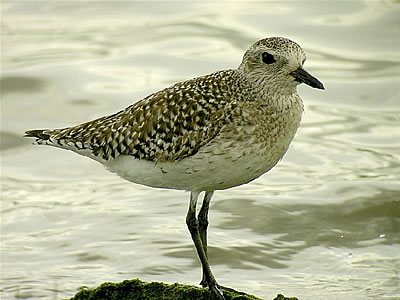
Birding the Richardson Bay shore (in early May), Don Reinberg and I spotted a group of 5 Black-bellied Plovers pushed up close to the shoreline path at high tide. Seems like the handsome alternate (breeding) plumage BB Plovers all left a few weeks ago, so these rather plain plovers were a bit of a surprise. Well, if I understand Paulson correctly, the first year BB Plovers don't usually molt into the usual alternate plumage, but rather something more restrained, as shown here. And since they haven't reached the age to breed successfully, they usually don't make the entire journey to the arctic. Rather, some stick around here, and others venture further north for the rest of the summer. So this bird is likely a bit under one year of age.
2. Spotted Sandpiper
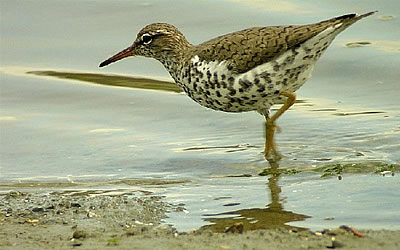
It's May, and the molt into breeding plumage is largely complete for many birds, and a lot of these have taken off to their breeding grounds. (It's not generally a good idea to make a long distance migration in the middle of a molt, as growing new feathers requires a lot of energy). It's been fun to watch the Spotted Sandpipers (Actitis macularia) grow into their name by adding breast spots over the past month.
This one was still patrolling his patch of shore in Richardson Bay a few days ago, looking rather dapper. The lighting does not do justice to his fine orange bill, and the photo is not the sharpest, but I still like the shot for its action. Note also how the feathers on the back have acquired some additional dark edges. These pipers move along at a good clip, which makes it a challenge to follow with a scope.
3. Black-chinned Sparrow
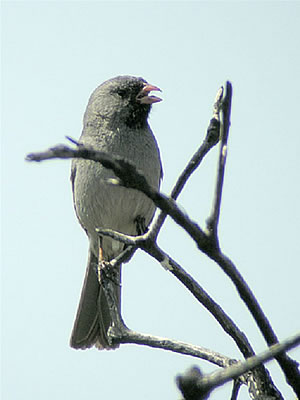
The Black-chinned Sparrow (Spizella atrogularis) is difficult to spot when not singing, as it forages deep in the chaparral. When we searched for it May 14th on Blue Ridge Road (80 toward Vacaville, north on Pleasant Valley Rd., to Mix Canyon Rd, then up 7 miles to mile-marker 7.2) it was singing up a storm from a prominent perch. The song ends in a trill not unlike that of the male Wrentit (i.e. accelerating, like a bouncing ping-pong ball).
Almost didn't post this sub-optimal photo, but it was the best I got and since it shows some of the field marks I figured some would like to check it out. Note the rather long tail, overall slender body (for a sparrow, anyway), and pink/orange bill. The area in front of the eyes and of course on the chin are black, accentuated here by being shaded. The photo shows that the gray of the head is darker than that on the chest and belly, whereas some illustrations (e.g. Sibley Guide) show little difference. The counter-shading seen in here may reflect the darker plumage of our local subspecies, the San Francisco Black-chinned Sparrow (S. a. caurina), but I'm not sure. Sort of has a junco-like look, don't you think?
4. I know, "Another Avocet....?"
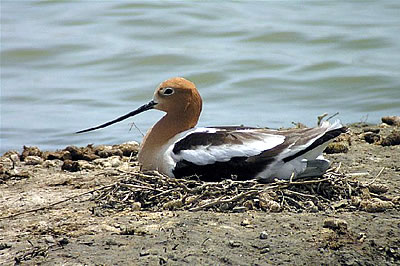
Well, if you were a photographer you couldn't resist either, especially when they sit serenely on their nests in the artificial pond at Shollenberger Marsh in Petaluma. This one was on a small island not far from the headquarters of PRBO Conservation Science. Both sexes incubate, and I'm guessing this is the male, as the female's bill is even more sharply upcurved. Of the 4 Avocet species in the world, the American Avocet (Recurvirostra americana) is the only one to change plumage color for the breeding season. Our local avocets do not migrate, whereas the majority of American Avocets do, mostly to alkaline inland lakes.
Sending this as reminder to visit Shollenberger soon, as it is a wonderful place to watch the antics of the Avocets and Stilts, both of whom are currently on eggs. And do stop in at PRBO Conservation Science at the southeast end to see their new headquarters.
5. House Wren
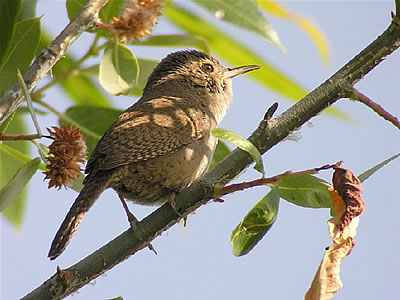
What is your favorite bird? Silly question really, but birding along Mines Road today we stopped first at Murietta's Well, and at the bridge we were serenaded by this House Wren (Troglodytes aedon). The male has a repertoire of up to 50 songs, most of which Sibley describes as ending with a "series of bubbling liquid trills." It occurred to me that if I could only have one bird in our yard (oh, the pain), then I might wish it to be the House Wren. The male sings up to 10 songs a minute, but like any skilled vocal artist he introduces enough variety to be endlessly entertaining. This ubiquitous little creature is also kind of cute. Not distinctive at all, but just plain CUTE! So today my favorite bird is the House Wren. And, "yes", the female sings too!
6. Spotted Towhee (Pipilo maculatus)
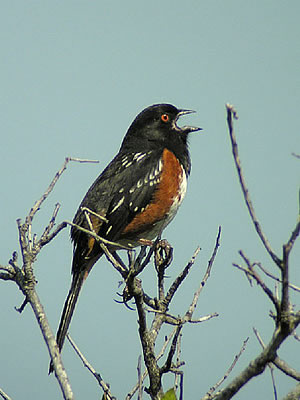
Still struggling to grasp avian taxonomy, so I thought I'd share my latest discoveries, based largely on John B. Dunning, Jr.'s piece on the Emberizidae Family in the Sibley Guide to Bird Life and Behavior. The Emberizidae are the "American Sparrows", or a new world group of seed-eating birds in the larger group of new world passerines that have 9 primary feathers. Currently included in the emberizidae are the Towhees, Sparrows, Longspurs, and certain Buntings. Not included are the Finches, Tanagers and Cardinals (Grosbeaks, etc.). The Towhees (Genus Pipilo) are the largest of the new world sparrows, and in Northern California we can see and hear the California Towhee and the Spotted Towhee on a year-round basis. There are currently seven species in the Pipilo genus, six of which are found in the U.S. (The White-throated Towhee is a Mexican endemic). It's not that we are hoping to discover new species, but the lumpers and splitters change the numbers every decade or so. For instance, we have lost the venerable species of "Rufous-sided Towhee", which has been split into our Spotted Towhee, and the Eastern Towhee. The Spotted Towhee (Pipilo maculatus) is shown here, seen today (May) on the lower portion of the trail up Ring Mountain, Marin County. They are still singing from perches, which makes them easy to spot (and photograph!) .
7. Lazuli Bunting (Passerina amoena)
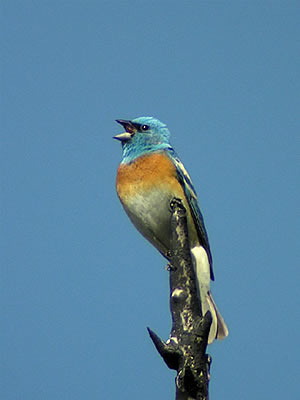
The male Lazuli Bunting (Passerina amoena) sings from a perch. The words go something like this:
"You think the sky is blue? Look at my head silly, look! Now you know what blue is!"
8. Clark's Grebe (Aechmophorus Clarkii)
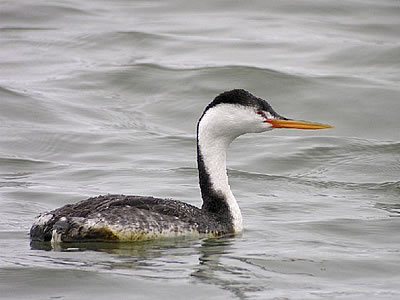
Clark's Grebe is more easily found this time of year (May). During the winter we see many Aechmophorus sp. grebes along the west coast, with the Western Grebe (A.cccidentalis) outnumbering Clark's (A. clarkii) by about 8:1. They both migrate to inland fresh waters across the western states to breed, but Clark's are more likely to stay around, so that their numbers approach 1:1 when compared to Westerns. Sibley's Guide and other do not distinguish the sexes, but some sources (e.g. Birds of N.A.) suggest that the bill is thicker and longer in the male. Both sexes have a more "cresty" look in breeding plumage, as shown here. The photo also shows what appears to be a color change in the bill, from yellow-orange at the tip to a distinctly more orange color at the base, something I never noticed before. The greenish discoloration at the waterline no doubt represents staining of the feathers. Western Grebe's bill is more greenish, and the Western never has a clear white spot in front of the eye.
TOWHEE.NET: Harry Fuller, 820 NW 19th Street, McMinnville, OR 97128
website@towhee.net